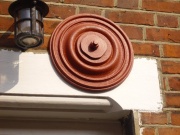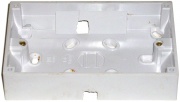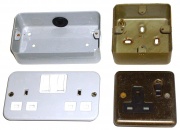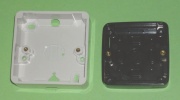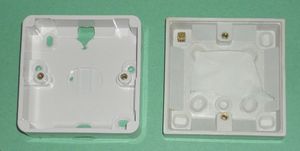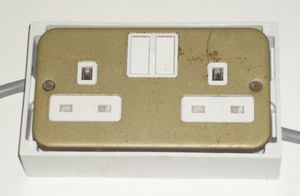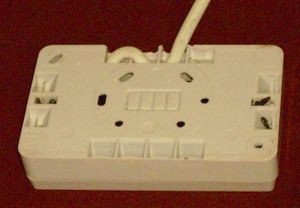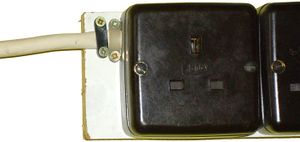Pattress
Pattress usually means the box that sits behind electrical sockets and switches, though it has other meanings too. Modern electrical pattress boxes come in metal and plastic, and in surface mount and flush versions.
Uses of the word 'pattress'
'Pattress' has more than one meaning in DIY. Its also a word whose meaning has changed relatively quickly over time, resulting in significant disagreement over which meanings are correct.
History
Pattress is derived from the latin 'pateras' meaning a shallow bowl or plate.
In the 1800s 'pattress' was used to mean the flat wooden plates that gas lighting equipment was mounted on.
In the 1930s electrical accessories were mounted on wooden plates, and these were mainly referred to as 'pateras.' The anglicised version 'pattress' gradually took over from pateras.
When wiring regs required electrical accessories to be housed in fireproof containers, a box was used between the wooden pateras and socket, instead of mounting it directly to the pateras. This was known as a pattress box. Over time this became known as a pattress.
Today many trade and DIY people refer to any electrical backbox as a pattress. There are also many that consider only surface mount boxes to be pattresses, and many that don't call any type of backbox a pattress. Unfortunately this is equally true of the other names for these things, so we just have to be aware of the differing usage of the term.
The electrical boxes used behind sockets and switches are variously known as pattresses, wiring accessory boxes, boxes, and backboxes, with none of these terms being universal.
Non-electrical pattresses
The word 'pattress' also describes flattish iron plates used for load spreading, as used to tie houses with structural defects together.
Pattress types
Metal flush mount pattress
Metal recessed pattresses are used to mount sockets & switches flush to a solid wall. A recess is chiselled out for the pattress to sit in. Knockouts are provided for cable entry. These are the most common domestic pattresses.
Plastic surface mount pattress
Plastic surface mount pattresses are used for electrical accessories that sit on the surface of walls. The pattress is screwed in place, and knockouts are provided for cable entry, either via the sides or the rear.
These are available in different depths. The shallowest ones are suitable for light switches where no screw block connections need to be made behind the switch. Deeper ones are usually used for sockets, but fitting sockets into shallow patresses is often possible, if tight, and light switches with a few screw block connections behind them will need the deep ones too.
Plastic surface mounting patresses are the second most common domestic type.
Stud wall pattress
Plasterboard boxes are used to flush mount switches etc to plasterboard. The picture shows the position of the grips before and after fitting.
Architrave pattress
Architrave pattresses are used with little architrave switches.
Metal surface pattress
Metal surface pattresses aren't very common in homes. They are used with metal accessories, and are ideal for workshops (and other environments) requiring particularly tough accessories.
Twin pattress
Twin pattresses are designed to take two single accessories. These are used when 2 different accessories in one position are wanted. These are not the same size as a double pattress.
Non-standard pattress
Non standard pattresses are sometimes seen. These generally don't fit standard sockets. They're designed to achieve some advantage, such as styling or compact size.
3 & 4 gang pattress
3 way socket convertors use a pattress designed to screw onto the top of an existing single flush mount pattress. These turn a 1 way flush socket into a 3 way surface mount socket. Sometimes the cables aren't long enough and need extending.
4 way socket convertors...
Grid switches
(pic wanted) Grid switch pattresses are another type not often seen in homes. These accept a number of accessories, which can be mixed at will in the one box. Available accessories include various switches, dimmers, key switches, indicators, etc. The accessories don't have any face plate, a single full size faceplate is fitted last. MK is known for its grid switch range.
Round conduit boxes
Round boxes forming part of a conduit system are sometimes seen in houses, though not often.
Junction boxes
[[image: |thumb]] Cables are often joined in pattresses, but their purpose is for mounting switches and sockets. When a container is wanted only for joining cables, a junction box is smaller & cheaper.
Depth
Plastic surface pattresses are widely available in different depths, ranging from 16mm (mainly for switches) to 47mm (mainly for sockets).
Other types of pattress are also found in different depths, but less often.
Mounting frames
6mm deep frames are available that can be used to effectively deepen an existing pattress. These are placed on the open front of the box, and space the accessory further from the back of the box.
Mounting frames are now available with built-in neons. These light up to make finding the switch in the dark easy.
Neons don't last forever, so connecting the neon supply across the switch contacts rather than from live to neutral can make them last a bit longer. This works fine with filament lighting, but not with CFLs, which would flicker when off.
Thermoplastic and Thermoset
Plastic pattresses intended for mains use are made from thermoset plastics, mainly white bakelite. These don't soften when hot, and act as a fire resistant container.
Similarly sized pattresses intended for phone networks are generally made from thermoplastics. These come in more than one size, the larger of which fits mains sockets. These can be bent slightly by hand, so are easily recognised. They offer no heat or fire protection and don't meet modern safety requirements for mains use.
Style & fit
Different brands of pattress have different corner detailing, intended to match their own brand of accessories. Standard pattresses, switches and sockets of different brands can be freely mixed, but the difference in corner detailing can make a minority of combinations look wrong. If mixing brands its best to check they look right together before buying.
Non-standard pattresses can't be expected to fit standard sockets.
Metal accessories
Many metal accessories for surface mounting are a different size to plastic pattresses. The screw spacing is the same, but the outer size isn't. These are an eyesore if one type is fitted to the other.
This problem doesn't occur with the various retrofit metal accessories on the market designed to fit standard plastic pattresses (and recessed metal ones). It only applies to the traditional functional metal sockets & backboxes.
Breakage
Screws holding plastic pattresses in place should be done up until the screwhead touches the pattress surface, and no more. Any further tightening is likely to break the brittle plastic.
Budget brand plastic pattresses can suffer a significant breakage rate during installation, particularly if a fair amount of hole needs to be made for cable entry, or if the underlying wall is not competely flat, or the installer doesn't appreciate their frailty.
Earth connection
Metal pattresses have an earth terminal for connecting to the circuit earth. A sleeved wire should be run from the socket earth terminal to the backbox.
2 core wiring
A small minority of houses still have old 2 core lighting circuits. Metal pattresses or accessories should not be fitted to such circuits due to the absence of anything more than functional insulation as protection against shock.
Sometimes people fit them and borrow an earth from a nearby socket circuit. This works but its not considered best practice, as there's always the possibility of the socket circuit being decommissioned later, leaving the lighting accessories unearthed. Hence its not wiring regulations compliant.
Plastic pattresses and accessories are the only type recommended for these circuits. However that doesn't imply that fitting them is always safe; some historic rubber wiring is so badly perished that moving the wires during fitting is sometimes a sizeable risk. If perishing is limited to just the wire ends, sleeving may be fitted to replace the function of the damaged insulation.
Extension leads
Surface pattress boxes are not designed for use on extension leads. They have no cordgrip, and are brittle, which is not ideal for portable use. Despite this they see fairly widespread use in extension leads, so we will describe how to make these not-recommended leads as safe as possible.
The main problem is the lack of cordgrip. There are 4 ways to implement a cordgrip.
- Knockout 3 of the knockouts in a row on one side/top/bottom of the pattress, and thread the lead through all 3 in a zigzag pattern. This makes a fully effective cordgrip.
- The pattess box can be mounted on a piece of wood and a cordgrip from a mains plug used to secure the lead inside the box. The 2 screws go into the backing wood.
- Knotting the wire is sometimes used, but this is only partially effective.
- A few surface pattress boxes do have cordgrips.
Breakability can be reduced to some extent by mounting the pattress box on a piece of chipboard that's larger all round than the box. Chipboard and MDF are best as they're soft enough to reduce peak impact forces.
